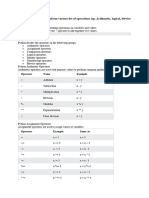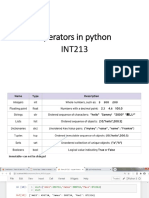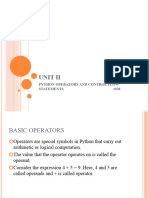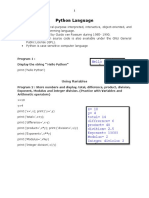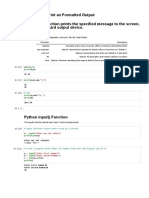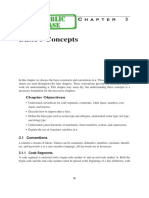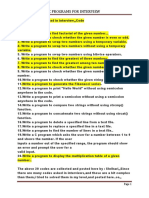Tutorial On Python 3
Python Operators
Operators are used to perform operations on variables and values.
Python divides the operators in the following groups:
Arithmetic operators
Assignment operators
Comparison operators
Logical operators
Identity operators
Membership operators
Bitwise operator
Python Arithmetic Operators
Symbol Operator Example
+ Addition x+y
- Subtraction x-y
* Multiplication x*y
/ Division x/y
% Modulus x%y
** Exponentiation x ** y
// Floor division x // y
In [1]: #Float Division
10/3
Out[1]: 3.3333333333333335
In [3]: # Floor Division or Int division
10//3
Out[3]: 3
In [4]: # Exponent opr
2**3
Out[4]: 8
In [ ]:
Python Comparison Operators
Symbol Operator Example
== Equal x == y
!= Not equal x != y
> Greater than x>y
< Less than x<y
>= Greater than or equal to x >= y
<= Less than or equal to x <= y
In [5]: 10 == 10
Out[5]: True
In [6]: 20>10
Out[6]: True
In [7]: 12.3<12
Out[7]: False
Python Logical Operators
Operator Description Example
and Returns True if both statements are true x < 5 and x < 10
or Returns True if one of the statements is true x < 5 or x < 4
not Reverse the result, returns False if the result is true not(x < 5 and x < 10)
In [8]: 10>5 and 10<20
Out[8]: True
In [9]: 10>5 and 20<10
Out[9]: False
In [10]: 10>5 or 20<10
Out[10]: True
In [11]: # Nonzero values are true and Zero false
not 10
Out[11]: False
In [12]: not 0
Out[12]: True
In [13]: not 12.4
Out[13]: False
Python Membership Operators
Membership operators are used to test if a sequence is presented in an object:
Operator Description Example
in Returns True if a sequence with the specified value is present in the object x in y
not in Returns True if a sequence with the specified value is not present in the object x not in y
In [16]: st = "red green yellow blue white"
'green' in st
Out[16]: True
In [17]: st = "red green yellow blue white"
'Green' in st
Out[17]: False
In [19]: st = "red green yellow blue white"
'black' not in st
Out[19]: True
identity operator
Identity Operator compare the memory location of two objects
Operator
is
is not
In [20]: a=10
b=10
print(id(a),id(b))
140718834033328 140718834033328
In [21]: a is b
Out[21]: True
In [22]: a is not b
Out[22]: False
In [23]: a=10
b=10.0
a is b
Out[23]: False
Bitwise operators
Bitwise operators act on operands as if they were string of binary digits. It operates bit by bit, hence the name.
In the table below: Let x = 10 (0000 1010 in binary) and y = 4 (0000 0100 in binary)
Operator Meaning Example
& Bitwise AND x& y = 0 (0000 0000)
Bitwise OR
~ Bitwise NOT ~x = -11 (1111 0101)
^ Bitwise XOR x ^ y = 14 (0000 1110)
>> Bitwise right shift x>> 2 = 2 (0000 0010)
<< Bitwise left shift x<< 2 = 40 (0010 1000)
In [24]: 10&4
Out[24]: 0
In [28]: 10&6
Out[28]: 2
In [29]: ~10
Out[29]: -11
In [30]: 10<<1
Out[30]: 20
In [31]: 10>>1
Out[31]: 5
Decision Making
What is an if statement?
An if statement tests for a condition, and then responds to that condition.
If the condition is true, then whatever action is listed next gets carried out.
You can test for multiple conditions at the same time, and respond appropriately to each condition.
In [3]: if 10<5:
print("10 is Greater")
print("hi")
print("hi")
print("hi")
print("Outside")
Outside
In [8]: # WAP to find largest number amoung two number
a=int(input("Enter first number"))
b=int(input("Enter Second number"))
if a>b:
print(f"{a} is largest")
else:
print(f"{b} is largest")
Enter first number12
Enter Second number34
34 is largest
In [ ]:
The if-elif...else chain
You can test whatever series of conditions you want to, and you can test your conditions in any combination you want.
In [11]: a=int(input("Enter first number"))
b=int(input("Enter Second number"))
c=int(input("Enter Third number"))
if a>b and a>c:
print(f"{a} is Largest")
elif b>c:
print(f"{b} is Largest")
else:
print(f"{c} is Largest")
Enter first number1
Enter Second number23
Enter Third number3
23 is Largest
In [6]: if 10-9:
print("True")
else:
print("False")
True
In [1]: not 0
Out[1]: True
True and False values
Every value can be evaluated as True or False. The general rule is that any non-zero or non-empty value will evaluate to
True.
In [2]: if 0:
print("This evaluates to True.")
else:
print("This evaluates to False.")
This evaluates to False.
In [7]: if -51:
print("This evaluates to True.")
else:
print("This evaluates to False.")
This evaluates to True.
In [8]: # Arbitrary non-zero numbers evaluate to True.
if 1253756:
print("This evaluates to True.")
else:
print("This evaluates to False.")
This evaluates to True.
In [9]: # Negative numbers are not zero, so they evaluate to True.
if -1:
print("This evaluates to True.")
else:
print("This evaluates to False.")
This evaluates to True.
In [13]: # An empty string evaluates to False.
if '':
print("This evaluates to True.")
else:
print("This evaluates to False.")
This evaluates to False.
In [14]: # Any other string, including a space, evaluates to True.
if ' ':
print("This evaluates to True.")
else:
print("This evaluates to False.")
This evaluates to True.
In [ ]: # Any other string, including a space, evaluates to True.
if 'hello':
print("This evaluates to True.")
else:
print("This evaluates to False.")
In [15]: # None is a special object in Python. It evaluates to False.
if None:
print("This evaluates to True.")
else:
print("This evaluates to False.")
This evaluates to False.
In [16]: a=None
In [18]: print(a)
None
In [19]: type(a)
Out[19]: NoneType
WAP that accepts marks of five subjects and finds percentage and prints grades according to th
e
following criteria:
Between 90-100%--------------Print „A‟
80-90%----------------------------Print „B‟
60-80%---------------------------Print „C‟
Below 60%----------------------Print „D‟
In [25]: m1 = float(input("Enter marks of m1 subject"))
m2 = float(input("Enter marks of m2 subject"))
m3 = float(input("Enter marks of m3 subject"))
m4 = float(input("Enter marks of m4 subject"))
m5 = float(input("Enter marks of m5 subject"))
total = float(input("Enter Total Marks"))
# per = sum of all marks / total marks * 100
per = (m1+m2+m3+m4+m5)/total *100
if per>=90 and per<=100:
print("A Grade")
elif per>=80 and per<90:
print("B Grade")
elif per>=60 and per<80:
print("C Grade")
else:
print('D Grade')
Enter marks of m1 subject50
Enter marks of m2 subject50
Enter marks of m3 subject50
Enter marks of m4 subject50
Enter marks of m5 subject50
Enter Total Marks500
D Grade
In [1]: # How we create empty Block of code
if 10>2:
pass
print("Hi")
Hi
In [ ]:
